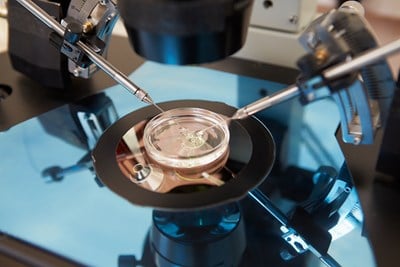In vitro fertilization, or IVF, is a complex treatment for infertility that works to help couples conceive a child. During IVF, an egg is removed from a woman’s ovaries and is joined in a test tube with a sperm cell. The cells fuse to form a zygote, which will become an embryo after it starts dividing.
Unlike artificial insemination, in which the sperm is placed in the uterus and conception happens normally, in vitro fertilization involves a baby being conceived completely outside of the mother’s womb. Since IVF was introduced in the United States in 1981, this technology has resulted in over 200,000 successful pregnancies. Even though IVF is the most effective form of assisted reproductive technology, only about 5% of couples struggling with infertility will seek it out because it is fairly expensive.
The Reasons For In Vitro Fertilization
Usually, if you and your partner are experiencing infertility, other methods to increase fertility are attempted before IVF. For example, it is common to take ovulation-inducing fertility medications that will increase the production of eggs or to undergo intrauterine insemination, sometimes both at the same time. However, if you or your partner have certain health conditions, then IVF may be offered as the primary treatment option. These include:
- Ovulation disorders: If your body does not produce eggs as regularly as it should, this can interfere with fertilization.
- Endometriosis: This condition can affect the function of the ovaries, uterus, and fallopian tubes.
- Fallopian tube damage or blockage: This makes it difficult for an egg to be fertilized or for the embryo to travel to the uterus.
- Uterine fibroids: These are benign tumors that grow along the wall of the uterus, and they can potentially interfere with the fertilization of an egg.
- Premature ovarian failure: If your ovaries don’t produce normal amounts of estrogen, then they will fail to function normally. If this happens before the age of 40, it is considered premature ovarian failure.
- Impaired sperm production or function: If your partner’s sperm is below average in concentration, has poor mobility, or is abnormal in size or shape, this can make it difficult for sperm to successfully fertilize an egg.
- Fertility preservation: If you have cancer or other health conditions that require damaging treatments such as chemotherapy or radiation, then you can harvest and preserve some of your eggs for future use.
- Genetic disorders: If you or your partner are at risk for passing on a genetic disorder to your child, then harvested eggs and sperm can be screened for certain genetic problems. Only the embryos that don’t contain the identified problems would be implanted in the uterus.
- Unexplained infertility: If there is no known cause for you or your partner’s infertility, despite extensive testing, then IVF might be an option.
- Previous tubal sterilization: If you have undergone tubal ligation, which is the sterilization of your fallopian tubes to permanently prevent pregnancy, then IVF could be an alternative instead of tubal ligation reversal.
The Risks of In Vitro Fertilization
There are some risks associated with IVF. These include:
- Premature delivery and/or low birth weight
- Miscarriage
- Ovarian hyperstimulation syndrome
- Multiple births
- Birth defects
- Ectopic pregnancy
- Ovarian cancer
The Results of In Vitro Fertilization
Your doctor will take a blood sample anywhere from ten days to two weeks after the procedure to test whether or not you are pregnant. Your chance of success with IVF depends on certain factors, such as your age, the status of the embryo when it was implanted, your reproductive history, the cause of your infertility, and other lifestyle factors. If you do not become pregnant the first time, you can talk with your doctor about how to increase your chances of getting pregnant using IVF if you choose to attempt another cycle.



